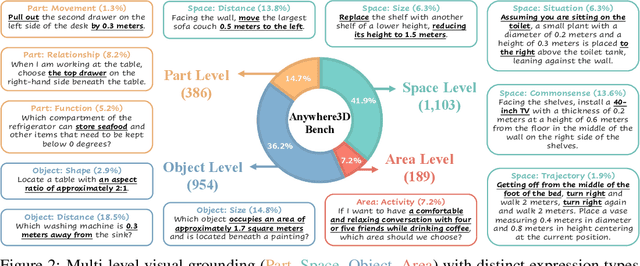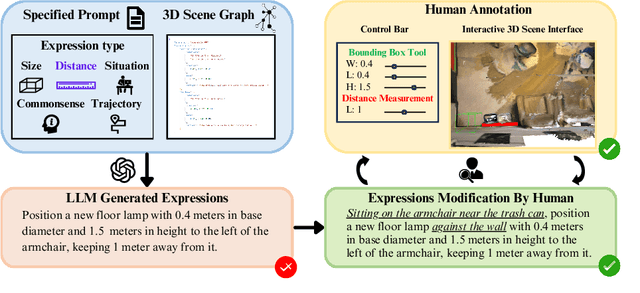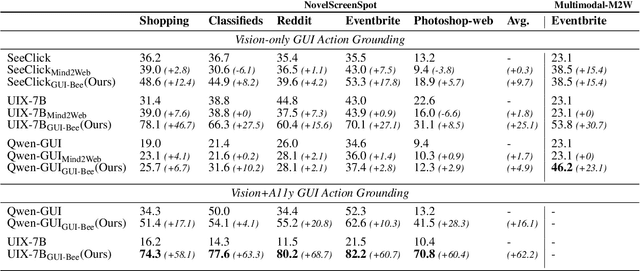Yue Fan
Reasoning Within the Mind: Dynamic Multimodal Interleaving in Latent Space
Dec 17, 2025Abstract:Recent advancements in Multimodal Large Language Models (MLLMs) have significantly enhanced cross-modal understanding and reasoning by incorporating Chain-of-Thought (CoT) reasoning in the semantic space. Building upon this, recent studies extend the CoT mechanism to the visual modality, enabling models to integrate visual information during reasoning through external tools or explicit image generation. However, these methods remain dependent on explicit step-by-step reasoning, unstable perception-reasoning interaction and notable computational overhead. Inspired by human cognition, we posit that thinking unfolds not linearly but through the dynamic interleaving of reasoning and perception within the mind. Motivated by this perspective, we propose DMLR, a test-time Dynamic Multimodal Latent Reasoning framework that employs confidence-guided latent policy gradient optimization to refine latent think tokens for in-depth reasoning. Furthermore, a Dynamic Visual Injection Strategy is introduced, which retrieves the most relevant visual features at each latent think token and updates the set of best visual patches. The updated patches are then injected into latent think token to achieve dynamic visual-textual interleaving. Experiments across seven multimodal reasoning benchmarks and various model architectures demonstrate that DMLR significantly improves reasoning and perception performance while maintaining high inference efficiency.
Self-Evolving 3D Scene Generation from a Single Image
Dec 09, 2025Abstract:Generating high-quality, textured 3D scenes from a single image remains a fundamental challenge in vision and graphics. Recent image-to-3D generators recover reasonable geometry from single views, but their object-centric training limits generalization to complex, large-scale scenes with faithful structure and texture. We present EvoScene, a self-evolving, training-free framework that progressively reconstructs complete 3D scenes from single images. The key idea is combining the complementary strengths of existing models: geometric reasoning from 3D generation models and visual knowledge from video generation models. Through three iterative stages--Spatial Prior Initialization, Visual-guided 3D Scene Mesh Generation, and Spatial-guided Novel View Generation--EvoScene alternates between 2D and 3D domains, gradually improving both structure and appearance. Experiments on diverse scenes demonstrate that EvoScene achieves superior geometric stability, view-consistent textures, and unseen-region completion compared to strong baselines, producing ready-to-use 3D meshes for practical applications.
"PhyWorldBench": A Comprehensive Evaluation of Physical Realism in Text-to-Video Models
Jul 17, 2025Abstract:Video generation models have achieved remarkable progress in creating high-quality, photorealistic content. However, their ability to accurately simulate physical phenomena remains a critical and unresolved challenge. This paper presents PhyWorldBench, a comprehensive benchmark designed to evaluate video generation models based on their adherence to the laws of physics. The benchmark covers multiple levels of physical phenomena, ranging from fundamental principles like object motion and energy conservation to more complex scenarios involving rigid body interactions and human or animal motion. Additionally, we introduce a novel ""Anti-Physics"" category, where prompts intentionally violate real-world physics, enabling the assessment of whether models can follow such instructions while maintaining logical consistency. Besides large-scale human evaluation, we also design a simple yet effective method that could utilize current MLLM to evaluate the physics realism in a zero-shot fashion. We evaluate 12 state-of-the-art text-to-video generation models, including five open-source and five proprietary models, with a detailed comparison and analysis. we identify pivotal challenges models face in adhering to real-world physics. Through systematic testing of their outputs across 1,050 curated prompts-spanning fundamental, composite, and anti-physics scenarios-we identify pivotal challenges these models face in adhering to real-world physics. We then rigorously examine their performance on diverse physical phenomena with varying prompt types, deriving targeted recommendations for crafting prompts that enhance fidelity to physical principles.
LEO-VL: Towards 3D Vision-Language Generalists via Data Scaling with Efficient Representation
Jun 11, 2025



Abstract:Developing 3D-VL generalists capable of understanding 3D scenes and following natural language instructions to perform a wide range of tasks has been a long-standing goal in the 3D-VL community. Despite recent progress, 3D-VL models still lag behind their 2D counterparts in capability and robustness, falling short of the generalist standard. A key obstacle to developing 3D-VL generalists lies in data scalability, hindered by the lack of an efficient scene representation. We propose LEO-VL, a 3D-VL model built upon condensed feature grid (CFG), an efficient scene representation that bridges 2D perception and 3D spatial structure while significantly reducing token overhead. This efficiency unlocks large-scale training towards 3D-VL generalist, for which we curate over 700k high-quality 3D-VL data spanning four domains of real-world indoor scenes and five tasks such as captioning and dialogue. LEO-VL achieves state-of-the-art performance on a variety of 3D QA benchmarks, including SQA3D, MSQA, and Beacon3D. Ablation studies confirm the efficiency of our representation, the importance of task and scene diversity, and the validity of our data curation principle. Furthermore, we introduce SceneDPO, a novel post-training objective that enhances the robustness of 3D-VL models. We hope our findings contribute to the advancement of scalable and robust 3D-VL generalists.
From Objects to Anywhere: A Holistic Benchmark for Multi-level Visual Grounding in 3D Scenes
Jun 05, 2025



Abstract:3D visual grounding has made notable progress in localizing objects within complex 3D scenes. However, grounding referring expressions beyond objects in 3D scenes remains unexplored. In this paper, we introduce Anywhere3D-Bench, a holistic 3D visual grounding benchmark consisting of 2,632 referring expression-3D bounding box pairs spanning four different grounding levels: human-activity areas, unoccupied space beyond objects, objects in the scene, and fine-grained object parts. We assess a range of state-of-the-art 3D visual grounding methods alongside large language models (LLMs) and multimodal LLMs (MLLMs) on Anywhere3D-Bench. Experimental results reveal that space-level and part-level visual grounding pose the greatest challenges: space-level tasks require a more comprehensive spatial reasoning ability, for example, modeling distances and spatial relations within 3D space, while part-level tasks demand fine-grained perception of object composition. Even the best performance model, OpenAI o4-mini, achieves only 23.57% accuracy on space-level tasks and 33.94% on part-level tasks, significantly lower than its performance on area-level and object-level tasks. These findings underscore a critical gap in current models' capacity to understand and reason about 3D scene beyond object-level semantics.
GRIT: Teaching MLLMs to Think with Images
May 21, 2025Abstract:Recent studies have demonstrated the efficacy of using Reinforcement Learning (RL) in building reasoning models that articulate chains of thoughts prior to producing final answers. However, despite ongoing advances that aim at enabling reasoning for vision-language tasks, existing open-source visual reasoning models typically generate reasoning content with pure natural language, lacking explicit integration of visual information. This limits their ability to produce clearly articulated and visually grounded reasoning chains. To this end, we propose Grounded Reasoning with Images and Texts (GRIT), a novel method for training MLLMs to think with images. GRIT introduces a grounded reasoning paradigm, in which models generate reasoning chains that interleave natural language and explicit bounding box coordinates. These coordinates point to regions of the input image that the model consults during its reasoning process. Additionally, GRIT is equipped with a reinforcement learning approach, GRPO-GR, built upon the GRPO algorithm. GRPO-GR employs robust rewards focused on the final answer accuracy and format of the grounded reasoning output, which eliminates the need for data with reasoning chain annotations or explicit bounding box labels. As a result, GRIT achieves exceptional data efficiency, requiring as few as 20 image-question-answer triplets from existing datasets. Comprehensive evaluations demonstrate that GRIT effectively trains MLLMs to produce coherent and visually grounded reasoning chains, showing a successful unification of reasoning and grounding abilities.
Rethinking Visual Layer Selection in Multimodal LLMs
Apr 30, 2025Abstract:Multimodal large language models (MLLMs) have achieved impressive performance across a wide range of tasks, typically using CLIP-ViT as their visual encoder due to its strong text-image alignment capabilities. While prior studies suggest that different CLIP-ViT layers capture different types of information, with shallower layers focusing on fine visual details and deeper layers aligning more closely with textual semantics, most MLLMs still select visual features based on empirical heuristics rather than systematic analysis. In this work, we propose a Layer-wise Representation Similarity approach to group CLIP-ViT layers with similar behaviors into {shallow, middle, and deep} categories and assess their impact on MLLM performance. Building on this foundation, we revisit the visual layer selection problem in MLLMs at scale, training LLaVA-style models ranging from 1.4B to 7B parameters. Through extensive experiments across 10 datasets and 4 tasks, we find that: (1) deep layers are essential for OCR tasks; (2) shallow and middle layers substantially outperform deep layers on reasoning tasks involving counting, positioning, and object localization; (3) a lightweight fusion of features across shallow, middle, and deep layers consistently outperforms specialized fusion baselines and single-layer selections, achieving gains on 9 out of 10 datasets. Our work offers the first principled study of visual layer selection in MLLMs, laying the groundwork for deeper investigations into visual representation learning for MLLMs.
Multi-Layer Visual Feature Fusion in Multimodal LLMs: Methods, Analysis, and Best Practices
Mar 08, 2025Abstract:Multimodal Large Language Models (MLLMs) have made significant advancements in recent years, with visual features playing an increasingly critical role in enhancing model performance. However, the integration of multi-layer visual features in MLLMs remains underexplored, particularly with regard to optimal layer selection and fusion strategies. Existing methods often rely on arbitrary design choices, leading to suboptimal outcomes. In this paper, we systematically investigate two core aspects of multi-layer visual feature fusion: (1) selecting the most effective visual layers and (2) identifying the best fusion approach with the language model. Our experiments reveal that while combining visual features from multiple stages improves generalization, incorporating additional features from the same stage typically leads to diminished performance. Furthermore, we find that direct fusion of multi-layer visual features at the input stage consistently yields superior and more stable performance across various configurations. We make all our code publicly available: https://github.com/EIT-NLP/Layer_Select_Fuse_for_MLLM.
Multimodal Inconsistency Reasoning (MMIR): A New Benchmark for Multimodal Reasoning Models
Feb 22, 2025Abstract:Existing Multimodal Large Language Models (MLLMs) are predominantly trained and tested on consistent visual-textual inputs, leaving open the question of whether they can handle inconsistencies in real-world, layout-rich content. To bridge this gap, we propose the Multimodal Inconsistency Reasoning (MMIR) benchmark to assess MLLMs' ability to detect and reason about semantic mismatches in artifacts such as webpages, presentation slides, and posters. MMIR comprises 534 challenging samples, each containing synthetically injected errors across five reasoning-heavy categories: Factual Contradiction, Identity Misattribution, Contextual Mismatch, Quantitative Discrepancy, and Temporal/Spatial Incoherence. We evaluate six state-of-the-art MLLMs, showing that models with dedicated multimodal reasoning capabilities, such as o1, substantially outperform their counterparts while open-source models remain particularly vulnerable to inconsistency errors. Detailed error analyses further show that models excel in detecting inconsistencies confined to a single modality, particularly in text, but struggle with cross-modal conflicts and complex layouts. Probing experiments reveal that single-modality prompting, including Chain-of-Thought (CoT) and Set-of-Mark (SoM) methods, yields marginal gains, revealing a key bottleneck in cross-modal reasoning. Our findings highlight the need for advanced multimodal reasoning and point to future research on multimodal inconsistency.
GUI-Bee: Align GUI Action Grounding to Novel Environments via Autonomous Exploration
Jan 27, 2025



Abstract:Graphical User Interface (GUI) action grounding is a critical step in GUI automation that maps language instructions to actionable elements on GUI screens. Most recent works of GUI action grounding leverage large GUI datasets to fine-tune MLLMs. However, the fine-tuning data always covers limited GUI environments, and we find the performance of the resulting model deteriorates in novel environments. We argue that the GUI grounding models should be further aligned to the novel environments to reveal their full potential, when the inference is known to involve novel environments, i.e., environments not used during the previous fine-tuning. To realize this, we first propose GUI-Bee, an MLLM-based autonomous agent, to collect high-quality, environment-specific data through exploration and then continuously fine-tune GUI grounding models with the collected data. Our agent leverages a novel Q-value-Incentive In-Context Reinforcement Learning (Q-ICRL) method to optimize exploration efficiency and data quality. Additionally, we introduce NovelScreenSpot, a benchmark for testing how well the data can help align GUI action grounding models to novel environments and demonstrate the effectiveness of data collected by GUI-Bee in the experiments. Furthermore, we conduct an ablation study to validate the Q-ICRL method in enhancing the efficiency of GUI-Bee. Project page: https://gui-bee.github.io
 Add to Chrome
Add to Chrome Add to Firefox
Add to Firefox Add to Edge
Add to Edge